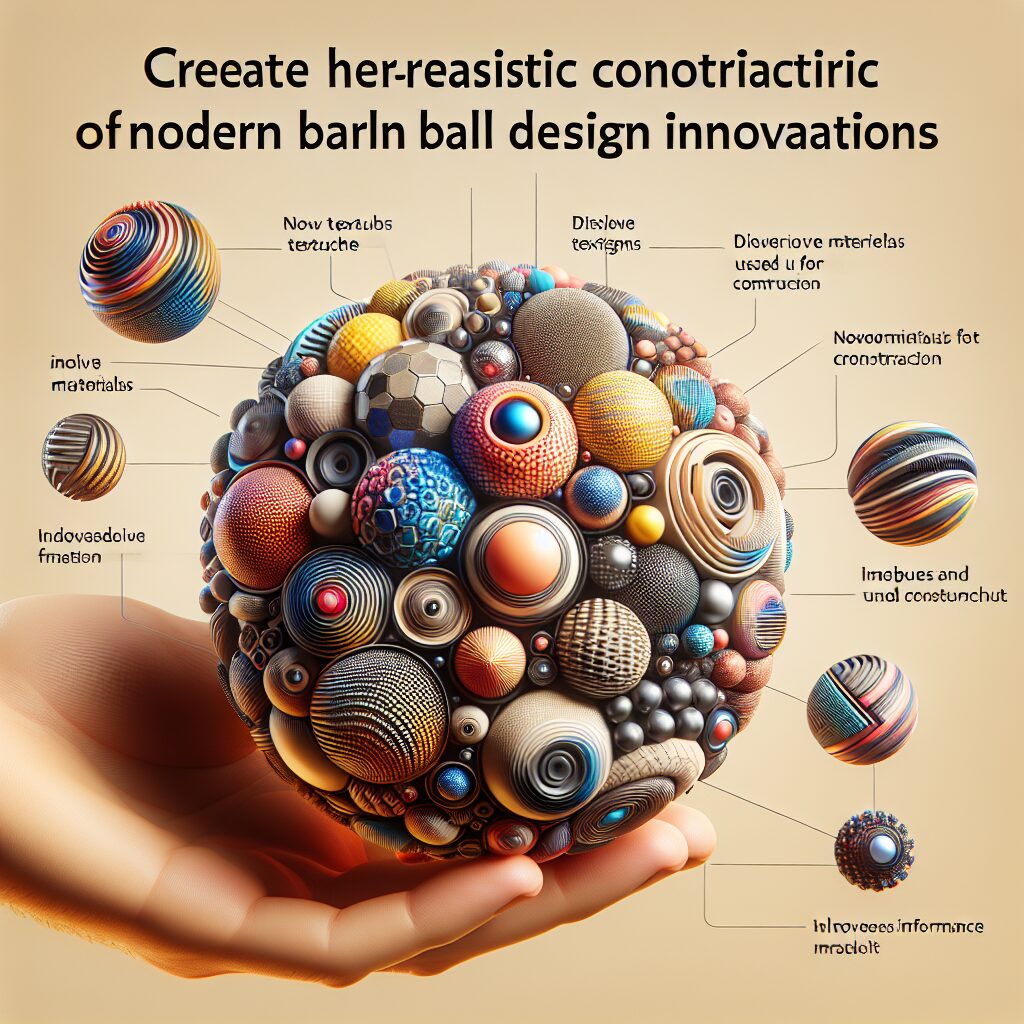Innovations in Modern Ball Design have revolutionized the way sports are played and enjoyed. A fundamental aspect of any sport, the design of the ball is crucial in enhancing performance and overall playing experience. With advancements in technology and materials, modern ball design has seen remarkable improvements in terms of aerodynamics, durability, and precision.
One of the defining features of modern ball design is the emphasis on aerodynamics. Manufacturers have developed innovative designs that minimize air resistance, enabling athletes to achieve greater speeds and accuracy in their movements. Additionally, the materials used in ball construction have improved significantly, enhancing durability and reducing the risk of damage during intense gameplay. These developments have had a profound impact on various sports, from soccer to tennis, and have contributed to more thrilling and competitive matches.
Moving forward, this article will delve into the key takeaways of innovations in modern ball design. We will explore how aerodynamics and material advancements have improved performance in sports like basketball, golf, and volleyball. Additionally, we will examine the impact of these innovations on player technique and strategy. By understanding the advancements in modern ball design, players and enthusiasts alike can gain a deeper appreciation for the intricate details that contribute to an incredible sporting experience.
Key Takeaways
1. Modern ball design has seen significant advancements, with innovative features like improved aerodynamics, better durability, and enhanced feel and performance.
2. Manufacturers are using cutting-edge technology, such as computer simulations and wind tunnel testing, to optimize ball design and reduce drag, leading to increased distance and accuracy.
3. The incorporation of specialized materials, like thermoplastic polyurethane and high-energy cores, has resulted in balls with enhanced energy transfer, higher initial velocity, and better overall performance.
4. Major golf ball manufacturers are investing heavily in research and development to create tailored solutions for different player types, including low-spin balls for higher swing speeds and high-spin balls for more control around the green.
5. The evolution of ball design has not only improved the game for professionals and elite players but has also benefited average golfers, offering them increased distance, improved control, and a superior overall playing experience.
What are the Key Innovations in Modern Ball Design?
Material Advancements
One of the major innovations in modern ball design is the utilization of advanced materials. Traditional balls were primarily made from leather or synthetic materials, but modern balls now incorporate high-tech materials such as polyurethane, thermoplastics, or even microfiber synthetic leather. These materials offer enhanced durability, improved grip, and better playability.
Aerodynamic Enhancements
Innovations in aerodynamics have greatly impacted ball design. The introduction of textured surfaces, like dimples or panels, has proven to reduce drag and increase the ball’s stability during flight. Manufacturers have also integrated sophisticated computer modeling techniques to optimize the ball’s shape, size, and surface patterns, enabling better control and accuracy when in motion.
Smart Technologies
In recent years, smart technologies have revolutionized ball design. Some modern balls are embedded with sensors that can track data such as speed, spin rate, trajectory, and impact force. These smart balls provide valuable insights for players and coaches to analyze their performance, identify areas for improvement, and enhance training methods.
Specialized Performance Features
Manufacturers have introduced various specialized features to cater to different sports and playing conditions. For example, in soccer, the use of teardrop-shaped panels or textured surfaces helps provide better ball control and improved trajectory. In basketball, advancements in panel alignment and bladder design offer enhanced grip, bounce, and shooting accuracy.
Sustainability and Eco-Friendly Initiatives
With growing environmental concerns, ball manufacturers are focusing on sustainability. They are developing eco-friendly materials, such as recycled plastics or organic compounds, to reduce the ecological impact of ball production. Additionally, efforts are being made to minimize water usage and waste during manufacturing processes.
Numbered Guides for Innovations in Modern Ball Design:
1. How to Choose the Right Ball
Consider the sport, playing surface, and intended level of play when selecting a ball. Assess the material, grip, durability, and any specialized features that align with your needs and preferences.
2. Caring for Your Ball
Extend the lifespan of your ball by properly maintaining it. Clean the ball regularly, avoid excessive exposure to sunlight or extreme temperatures, and store it in a suitable, dry environment to prevent damage.
3. Staying Updated with the Latest Innovations
Keep up-to-date with advancements in ball design by following industry news, attending sports equipment exhibitions, and exploring online resources. Stay informed about new materials, technologies, and features that could impact your game.
4. Embracing Smart Ball Technologies
If applicable to your sport, consider utilizing smart balls to gain valuable insights into your performance. Understand how to interpret the data provided and integrate it into your training regimen for continuous improvement.
5. Contributing to a Sustainable Future
Support sustainable ball manufacturing initiatives by choosing products made from eco-friendly materials. Educate yourself about environmentally conscious brands and consider the broader environmental impact of your sports equipment choices.
FAQ
1. How have modern innovations affected ball design?
Innovations in modern ball design have had a significant impact on various aspects. These advancements have resulted in improved performance, increased durability, and enhanced control for players. Technological breakthroughs have also led to the development of specialized balls for different sports, catering to the specific needs and requirements of athletes.
2. Are modern ball designs focused only on performance?
No, modern ball designs go beyond just performance. While performance remains a key aspect, innovations in ball design also emphasize safety, comfort, and sustainability. Manufacturers are actively incorporating eco-friendly materials and designs that minimize the environmental impact, ensuring a balance between performance and responsibility.
3. How do advancements in ball design impact players’ experience?
Advancements in ball design greatly enhance players’ experience by providing better handling and control. The incorporation of advanced materials and construction techniques improves the overall feel, reducing vibration and allowing for precise movements. These innovations ultimately contribute to a more enjoyable and satisfying playing experience.
4. Do modern ball designs affect injury rates?
Yes, modern ball designs contribute to the reduction of injuries. Manufacturers now prioritize safety features in the design process, incorporating technologies such as impact-absorbing layers and specialized surface textures. These advancements minimize the risk of injuries caused by impacts and accidents, ensuring a safer playing environment.
5. Are modern ball designs suitable for all skill levels?
Absolutely. Modern ball designs cater to various skill levels, from beginners to professional athletes. Manufacturers offer a range of options, including balls tailored for beginners seeking better control and forgiveness, as well as high-performance balls designed for advanced players looking for maximum power and precision.
6. What role does aerodynamics play in modern ball design?
Aerodynamics play a crucial role in modern ball design. Manufacturers invest significant resources into developing optimal aerodynamic profiles that reduce drag and optimize ball flight. This leads to increased accuracy, enhanced distance, and improved consistency, especially in sports like golf, tennis, soccer, and baseball.
7. How have advancements in materials affected ball design?
Advancements in materials have revolutionized ball design. The use of advanced materials, such as composite leathers, synthetic rubbers, and high-density foams, has resulted in enhanced durability, better grip, and improved overall performance. These materials also allow for greater customization and innovation in ball design.
8. Can modern ball designs affect game strategies?
Indeed, modern ball designs can impact game strategies. With improved control and performance, players can adapt their techniques to leverage the capabilities of these innovative balls. For example, in sports like basketball, where shooting precision is crucial, advancements in ball design can influence shooting strategies and improve scoring efficiency.
9. How do modern ball designs contribute to sustainability?
Modern ball designs are increasingly incorporating sustainable practices and materials. Manufacturers are adopting eco-friendly manufacturing processes, utilizing recycled materials, and exploring biodegradable alternatives. By considering the environmental impact, these innovations contribute to long-term sustainability and a healthier planet.
10. Are modern ball designs subject to regulations or standards?
Yes, modern ball designs must adhere to regulations and standards established by respective sports associations and governing bodies. These organizations define specific guidelines regarding ball size, weight, pressure, performance characteristics, and safety standards. Manufacturers must comply with these regulations to ensure fair play and maintain competitive integrity.
Final Thoughts
Modern ball design is a captivating blend of science, technology, and innovation. With each new advancement, we witness balls that not only elevate athletic performance but also prioritize sustainability and user experience. The constant push for improved materials, aerodynamics, safety features, and adaptability ensures that players across all skill levels can enjoy the benefits of these innovations.
The future of ball design holds great promise as manufacturers continue to explore novel materials, production techniques, and performance-enhancing strategies. As athletes push the boundaries of human capability, advancements in ball design will undoubtedly play a pivotal role in shaping the sports industry, making it more exciting, accessible, and sustainable for generations to come.




